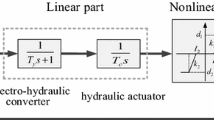Abstract
A preliminary discussion has been carried out on the traditional optimization design method for pressure-adjusting spring of relief valve. Based on the traditional optimization methods about the pressure-adjusting spring of the relief valve and combined with the advantages of neural network, this paper puts forward the optimization method with many parameters and a lot of constraints based on neural network in order to find the maximal inherent frequency. The object function of optimization is transformed into the energy function of the neural network and the mathematical model of neural network optimization about the pressure-adjusting spring of the relief valve is set up in this method which also puts forward its own algorithm. An example of application shows that network convergence gets stable state of minimization object function E, and object function converges to the utmost minimum point with steady function, then best solution is gained, which makes the design plan better. The algorithm of solution for the problem is effective about the optimum design of the pressure-adjusting spring. The specified technical performances of the relief valve are certified by experiments. The results of experiments showed that by configuring pressure-adjusting spring the dynamic performance and working stability of the relief valve are enhanced.

Similar content being viewed by others
References
Marcelin J-L (2004) A metamodel using neural networks and genetic algorithms for an integrated optimal design of mechanisms. Int J Adv Manuf Technol 24(9–10):708–714
Francis J (2000) Zone modelling of high-lift pressure relief valves. Build Serv Eng Res Technol 21(4):219–224
Eyres RD, Champneys AR, Lieven NAJ (2005) Modelling and dynamic response of a damper with relief valve. Nonlinear Dyn 40(2):119–147
Zung PS, Perng MH (2002) Nonlinear dynamic model of a two-stage pressure relief valve for designers. Trans ASME J Dyn Syst Meas Control 124(1):62–66
Imaizumi T, Ookouchi T, Ichikawa S (1991) Shape optimization of the wire cross section of a helical spring (1st Report, study on stress analysis and optimum design method). Nippon Kikai Gakkai Ronbunshu, C Hen/Trans Japan Soc Mech Eng Part C 57(537):1695–1701
Ku CS, Hajela P (1997) Integrated design of an adaptive neurocontroller for a 2-D aeroelastic system. Struct Optim 13(2–3):172–181
DiDomenico E (1993) Neural network techniques for disturbance rejection. Intell Eng Syst Artif Neural Netw (3):605–610
Hajela P, Lee E (1997) Rotorcraft subfloor design for enhanced crashworthiness characteristics. Appl Mech Rev 50(11):S72–S80
Qiao JW, Zhan YQ, Shi G (2002) Application of neural networks based on system architecture in nonlinear modeling. J Syst Simul 14(5):557–561
Xue Y, Watton JA (1995) Self-organizing neural network approach to data-based modelling of fluid power systems dynamics using the GMDH algorithm. Proceedings of the Institution of Mechanical Engineers, Part I. Journal of Systems and Control Engineering 209(I4):229–240
Li YL (1991) Hydraulic pressure component and system design. Beihang University Press, Beijing
Song J, Wang S (1999) The optimization of hydraulic pressure part. Mechanical Industry Press, Beijing
Fu X.-J. (2000) The optimum design of the loader’s working linkage based on neural networks. Mod Mach (1):76–78
Yokota T, Taguchi T, Gen M (1997) A solution method for optimal weight design problem of herical spring using genetic algorithms. J Comput Ind Eng 33:71–76
Fu X.-J. (2000) The fuzzy reliability optimization design of the spring. Mach Des Manuf (1):4–6
Chen X (1991) The machinery optimum design. Zhejiang University Press, Hangzhou
Hu S, Shen Q (1993) Nerve network application technology. National Defense University of Technology Press, Changsha
Tsujimura Y, Gen M, Ishizaki S (1997) Optimal routing in multiple I/O data network using neural network with perturbed engergy function. In: Proceedings of the 20th international conference on computers and industrial engineering, pp 477–480
Fu X.-J. (2000) The method of neural networks about the multi-objects optimal design of the disc brake. Mod Mach (2):6–10
Author information
Authors and Affiliations
Corresponding author
Rights and permissions
About this article
Cite this article
Fu, XJ. Study on optimal design of pressure-adjusting spring using artificial neural networks. Engineering with Computers 23, 55–60 (2007). https://doi.org/10.1007/s00366-006-0042-x
Received:
Accepted:
Published:
Issue Date:
DOI: https://doi.org/10.1007/s00366-006-0042-x



